Clematis - plants that often choose gardeners for their country sites. This is the perfect example of beautiful blooming plants that are pretty unpretentious in planting and care. In this article, let's talk about Clematis Variety Alyonushka, who was led in the Nikitsky Botanical Garden in the early 1960s. The variety has a lot of advantages and is great for growing in the regions with harsh winters.
Clematis Alyonushka - Description of the variety
Clematis's grade Alyonushka was removed in the early 1960s in the Crimea. Among the features of this variety, the following characteristics can be distinguished:
- clematis Alyonushka - plenty semi-staple, which refers to a group of solidal clematis, which can also be called a group of integorify;
- clematis Alyonushka - a perennial plant, which grows in the form of a liana. A feature of this variety is that Clematis shoots do not cling to supports, but they can rely on them;
- clematis Alyonushka can reach a height of 150 cm to 200 cm;
- clematis Alyonushka in the absence of any supports can perform with a spectacular soil plating;
- soothes from Clematis Alyonushka thin and flexible;
- the flowering period of Clematis Alyonushka begins at the end of June and lasts until August or September. The duration of flowering is considered one of the main advantages of this variety;
- clematis Clematis Flowers have a bell-shaped shape and pink color. Slightly twisted petals give the effects of the plant;
- clematis colors Alyonushka grade can reach in diameter from 5 cm to 8 cm and have about 4-5 petals;
- clematis Alyonushka forms inflorescences only on young shoots, which requires trimming of a 3rd type;
- clematis Alyonushka variety has pretty good frost-resistant characteristics, which allows you to grow this perennial in the regions with harsh winter conditions;
- the Clematis grade Alyonushka refers to the second group of clematis in the size of seeds. This means that the seeds of solid-choice Clematis Alyonushka have an average value.
Clematis Alyonushka - Photo
Clematis Alyonushka - reviews
- Igor A. "Alyonushka's grade liked me at one of the local markets. The seller assured in the high decorative properties of this perennial, and I purchased it. The seedling stuck pretty quickly. My plot is not distinguished by fertile soil, but Clematis felt quite comfortable. I advise this variety to all dackets. "
- Marina S. "Clematis is my love. We cultivate them for several years. In its plot, I can boast of excellent copies of Clematis of different varieties. In my collection there are Alyonushka. The variety turned out to be unusually sustainable to adverse weather conditions, which was very pleased with me. Alyonushka is blooming abundantly and large flowers, if it is strongly cropping. Inflorescences appear on the shoots of the current year. "
- Vlada R. "The variety of Alyonushka appeared to me at first glance with his name. With the cultivation of this clematis, I did not have any problems. It grows on my site for the 6th year and every summer pleases with amazing pink flowers. "
- Rimma P. "I, as a novice gardener, do not like complex agrotechnical actions with plants on the site. I choose the most beautiful, but also unpretentious options. Clematis Alyonushka attracted me by the fact that the plant does not require difficult preparation for the winter. I simply cut it around with the earth and sprinkle peat. I advise this decorative plant to all beginners in the horticultural business. "
Clematis Alyonushka. Landing
Step number 1. Choose a place to land Clematis Alyonushka
In order to fully enjoy the spectacular flowering of Clematis Alyonushka, you need to carefully approach the choice of places for planting this perennial. Try to take into account the following recommendations:
- clematis Alyonushka varieties prefers to grow on well-lit places, sexualized, places with moon shading;
- clematis Variety Alyonushka grows well on places protected from winds;
- if you plan to plant Clematis Alyonushka near the fence, then do not squeeze it closely. It is advisable to observe a distance of 30 cm;
- if you plan to plant Clematis of Alyonushka's variety near the wall of the house, then provide that water from the roof does not fall on the plant;
- if on your site, groundwater is too close to the surface, then take care of a good drainage layer when planting a plant. It is advisable to choose an elevated place or to build a hill for landing;
- clematis Alyonushka, like most of the other varieties of Clematis, is very demanding about moisture. Water should not linger at the roots even for a short time. Near the place of landing of Clematis, it is necessary to provide a natural system of water outflow. For a plant, not only groundwater can be destructive, which flow close to the surface of the earth, but also the melting water in spring.
Step number 2. Choose time for landing Clematis Alyonushka
Plant Clematis Variety Alyonushka can be both in spring and autumn. If you bought a seedling in a container, then it can be seen almost at any time of the year, except for winter. If the planting material was bought in late autumn, and time for landing does not remain, then it can be saved until spring. Just place Clematis into the room with a temperature not higher than 5 degrees of heat and sprinkle the roots with wet soil. Periodically examine the seedling. In order for the seedling "not waking up" ahead of time, you need to shoot it a bit.
Step number 3. We choose the ground for landing Clematis Alyonushka
- Clematis Alyonushka prefers to grow on fertile sublibious soils that are well drained.
- Clematis Alyonushka prefers to grow on nutritional and fertile slightly alkaline soils.
To preparing the landing pit for Clematis, Alyonushka variety is expected to treat special attention. This decorative perennial can grow in one place under 20 years.
Step number 4. Preparation of landing pit for Clematis Alyonushka
- For single landing of Clematis Variety Alyonushka digging the landing jam with dimensions of 60 cm * 60 cm * 60 cm. If you plan to land several plants at the same time, the entire area is prepared for landing.
- At the bottom of the landing pits, the drainage layer is poured with a thickness of at least 15 cm. If the site for planting Clematis is distinguished by high fitting of groundwater, then the drainage layer can be increased.
- To the ground that dug out of the pit, you need to notice 2-3 buckets of compost or humoring, 1 bucket of peat, 1 sand bucket, 150 grams of superphosphate, about 200 grams of lime, 200 grams of ash. Clematis Variety Alyonushka prefers to grow on the nutritional soil, and therefore it will not be superfluous to add a complex mineral organic fertilizer.
- If on the site that is intended for landing Clematis Alyonushka, the clay and heavy soil prevails, then you need to add sand, crushed stone, broken brick.
Step number 4. Landing Technology Clematis Alyonushka
- After you have prepared a landing hole, the soil made more nutritious, you can begin the process of planting Clematis Variety Alyonushka. If the roots of the seedling dried a little, then they should be soaked in water. Some gardeners also prefer to free the roots from the earthen coma from a seedling that was purchased in the store. But it is necessary to do it as carefully, trying not to damage the roots of the plant.
- In the landing point center, it is necessary to place some solid support that will protect the long shoots of the semi-staple.
- Place in the pit approximately half the volume of the land that you dug. Build in the center of a small hollyk.
- The roots of the seedling should be placed on the hilly in such a way that they can lying freely.
- Holding the seedling with the hand, carefully fall asleep the hole of the earth. Clematis Alyonushka, like most of the other varieties of Clematis, requires a plated landing. Only, in this case, the plant will develop the center of adversaries, and it will better endure unfavorable environmental conditions. If you plant Clematis Vrown with the surface of the Earth, then the plant will not have or decorative qualities or durability. The older and the larger seedling, the greater the bulk it will require when landing. If the young Clematis is plugged when landing by 8-10 cm, then more adult - by 12-18 cm.
- If the landing of the Clematis variety Alyonushka is produced in the spring, it is very important to observe the degree of filling the landing pit when landing. The pit does not fall asleep about 5-8 cm. Only after the young Clematis will begin to win the shoots, the pit is gradually filled to the edge.
- After planting, the plant is watered and necessarily mulch the rolling circle peat or other material.
- With the autumn landing of Clematis Alyonushka, which is more often used in the regions with the southern climate, uses a different way to plant. The landing pit is prepared in the same way as at the spring landing. However, the pit when landing needs to fill in a closure with the surface of the Earth. Then the young clematis is watered and mulched with dry leaves. In the spring of the Earth, it will be necessary to dig away from the rolling circle. In the process of winning the shoots, the pit is gradually filled again to the top.
Clematis Alyonushka. Care
Clematis care features Alyonushka in open ground
- Clematis Variety Alyonushka, like most of the other varieties of Clematis, loves good and regular watering. It is necessary to water about 1 time per week, and in dry and hot weather - 2-3 times a week.
- The older Clematis, the more water is required when watering. A young perennial will be enough 10-20 liters of water in one watering, and an adult - 20-30 liters.
- Some gardeners in order to prevent soil drying, use the next reception. Around Clematis Alyonushka can be buried in the ground several pots that have holes at the bottom. Rainwater will be collected in pots, and Clematis will "pull out" water as needed.
- When irrigating Clematis, Alyonushka varieties also need to try not to fall into the center of the semi-station.
- If you prefer not to mulch the soil around Clematis Alyonushka, then you will have to loose land after irrigation. But it is better not to neglect this recommendation. The mulch layer will not only prevent too fast evaporation of moisture, but also to restrain the growth of weed grass.
- Clematis Variety Alyonushka, like any other decorative plant in the garden, requires regular weeding. Wearing grass not only spoils the appearance of landing, but also contributes to the infection of the plant with diseases and pests.
- Regular inspection of Clematis is needed in order to notice damaged shoots in time, faded flowers, the first signs of any disease, pests.
Feed Clematis Alyonushka
Decorative semi-stapler Clematis varieties Alyonushka positively refers to making feeding. But you need to comply with the following recommendations:
- in the first year of life, young Clematis does not need additional feeding. He will be enough those nutrient elements with which the Earth was enriched in the preparation of landing pit;
- during the season, Clematis is preferably to feed at least 4 times. Usually, gardeners alternate organic fertilizers with minerals. In the role of mineral fertilizers, you can use complex finished additives that are purchased in specialized stores. And as an organic feeding, you can use a diluted korovyan in the water in the calculation of 1:10;
- over the season, you can finish Clematis Alyonushka with a solution of boric acid (1-2 gr) and potassium mangartage (2-3 gr) on 10 liters of water;
- spring Clematis Alyonushka is advised to water lime milk;
- during the formation of buds, the plant can be filled with potash fertilizers, but at the time of active bloom, it is not necessary to fertilize the half-welfare.
Create support for Clematis Alyonushka
Since Clematis Alyonushka belongs to the integrality group, it is not necessary to create some kind of complex design for support. This perennial is not able to touch the support. If you plant the plant of this variety near the fence, gazebos, walls, then, as Clematis is growing, it will have to be periodic to tie it several times per season. You can not touch the stems at all, and then the long-term semi-staple will grow as a soil plant.
Clematis Alyonushka - wintering
Clematis Variety Alyonushka got widespread due to its unpretentiousness in care. The organization of conditions for wintering this plant will also not submit difficulties for the novice gardener. Clematis of the integraty group form inflorescences on the shoots of the current year. This means that there is no need to save shoots to spring. Clematis Alyonushka autumn is subject to circumcision under the root. Although the plant has good frost-resistant characteristics, it is better to protect its root system from frost. You can simply pour out from above 1 bucket of peat, and this will be enough Clematis for comfortable wintering. Experienced gardeners also advise to handle the root neck with a solution of copper sulfate.
Trimming Clematis Alyonushka
Clematis Variety Alyonushka refers to the 3rd group of cropping clematis. Plants of this species form flowers only on young shoots of the current year, and therefore trimming is the strongest. In the fall, Clematis shoots are completely cut. Some gardeners prefer to cut shoots, leaving 2-3 kidney pairs, which approximately corresponds to 20-50 cm from the ground level. It is such a strong type of trimming that guarantees large flowers next year.
Methods of breeding Clematis Alyonushka
Clematis reproduction Alyonushka seeds
Gardeners rarely choose a seed method of breeding clematis, since the grown plants of popular large-flowered varieties will not repeat the decorative characteristics of the parent plant. If you want to try to grow Clematis Alyonushka's variety in this way, then follow the following recommendations:
- alyonushka variety refers to the second group of Clematis in the magnitude of the seed. They have an average size. It is advisable to use seeds collected in the current year. If you store the sowing material in paper bags, then it will not lose his gerbus for 4 years;
- seed seeds need in the second half of winter;
- in order for the process of germination of Clematis seeds to be as fast as possible, they need to be soaked in water for 10 days. The more often you will change the water, the better. The optimal frequency is 4-5 times a day;
- prepare small containers in which you will germinate seeds. Nutrient soil must consist of equal parts of peat and sand;
- before planting seeds, the ground must be moistened;
- spread seeds on the surface of the soil and sprinkle it with sand. The thickness of the sand layer should approximately be 2-3 seed diameters;
- the planting container needs to be covered with a film or glass and put into the room with a temperature of about 25-30 degrees of heat;
- regularly check your landing of Clematis. Remove the condensate from the inner surface of the glass or film, remove weeds, water into the pallet so that the seeds do not wash away;
- the first shoots of Clematis Alyonushka should provide good lighting, but take care of direct sunlight;
- young Clematis are picked in separate containers after the real leaves appear;
- in the spring seedlings can be planted in an open ground. Choose wind protected and shady space. Plants planted at a minimum distance from each other at 15-20 cm. It is very important to pinch young seedlings so that they increase the root system and branched it harder;
- approximately 2-3 years old plants will be ready to transplanted them to a permanent place of growth. By this time, Clematis Alyonushka will shoot 10-15 cm long.
Clematis breeding Alyonushka cuttings
Clematis, including the variety of Alyonushka, are perfectly reproduced by green or weathered cuttings. It is this way that is most often used in the breeding of Clematis on an industrial scale. Clematis grown from Chenkov are characterized by good characteristics, as they grow on their own root system. Before boarding the cutting, it is necessary to process any of the modern corpsulatory drugs. Ideal temperature regime for rooting Clematis Cherenkov - 18-20 degrees of heat. Landing should be protected from direct sunlight and rebupping moisture.
Clematis reproduction Alyonushka messengers
Try to propagate Clematis Alyonushka can be in spring. Radially from the bush dig up the grooves of a depth of 5-10 cm and put shoots into them. The shoots fall asleep and fixed with the help of a bracket. After the chain is well rooted, it is separated from the parent plant. It should be borne in mind that with this method, all diseases of the mother's bush are transferred to new clematis.
Clematis reproduction Alyonushka division bush
A popular method of reproduction of adult clematis, which is also suitable for breeding a variety of Alyonushka. You can separate perennials that are already more than 5-6 years. To do this, it is necessary to neatly dig a bush and divide it on as many parts, as long as its size allows. If the bush is too big, and it is completely difficult to dig it, then Clematis can die on one side and separate part. It is necessary to plant each part of the bush according to the method described in the "Landing" section in this article. The main advantage of this method of breeding Clematis Alyonushka is the rapid flowering of new plants. The lack of a bush division - a new plant adapts all the diseases of the mother bush.
We defend Clematis Alyonushka from diseases and pests
Unfortunately, Clematis Variety Alyonushka, like most decorative plants in the garden, can be subject to various fungal and viral diseases:
- withering is a fungal disease of Clematis, which can be seen by losing elasticity parts of the plant. Most often, gardeners notice the symptoms of this illness in spring. Clematis begins to suddenly dry. The causative agent of fading lies in the ground, where it begins to actively hit the root system of perennial. Processing the affected plants are needed by a solution of Fundazola or another similar means;
- rust is a disease of Clematis, which can be recognized on the "pads" of rusty color on the leaves, fading and deforming the leaves. Damaged parts of the perennial need to be removed, and the plant to process the burglar mixture;
- yellow mosaic is a viral disease, whose symptoms are spots on the leaves of the plant and their deformation. Amazed Clematis, unfortunately, will have to destroy. In order to prevent prevention, it is better not to plant this decorative semi-staple near peonies, hosts, phloals, which are most strongly susceptible to this viral disease.
From pests that can harm Clematis Alyonushka, you can note a gallium or leaf nematode, which actively affect the root system of the plant. Gradually amazed Clematis die, and they need to be removed. In addition, landing on the same place of new clemats should be avoided for a long time.

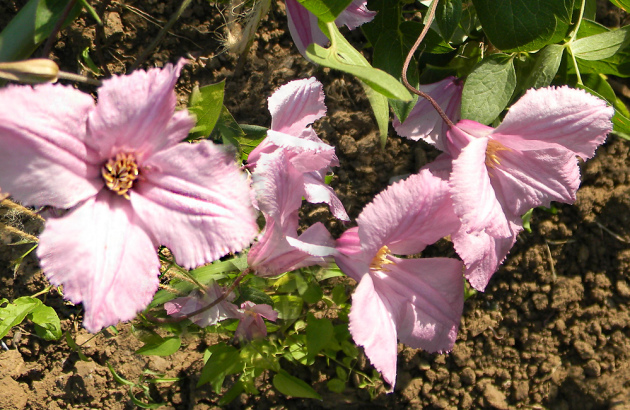


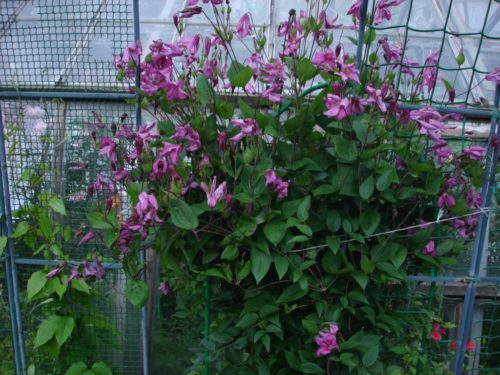
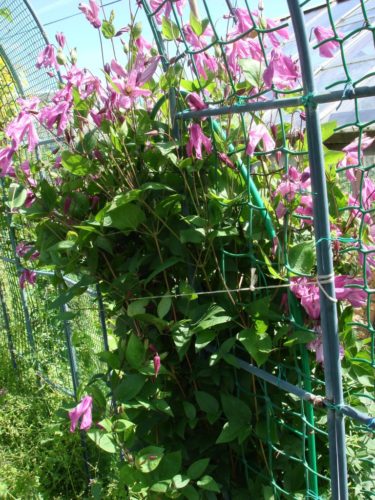

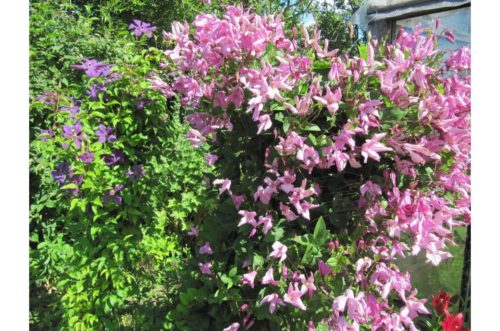
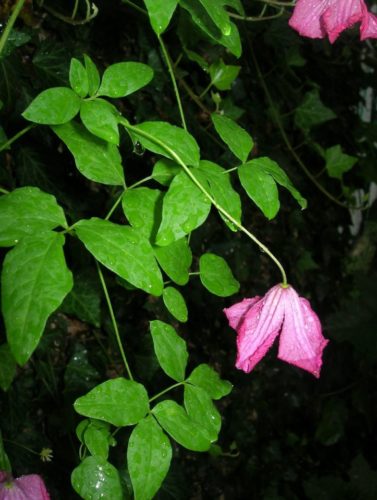
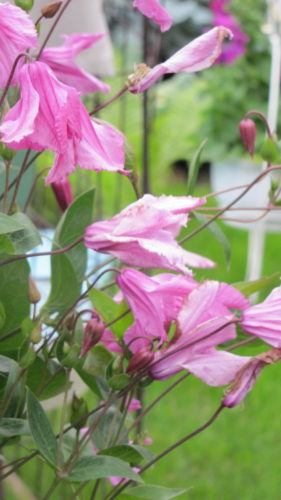
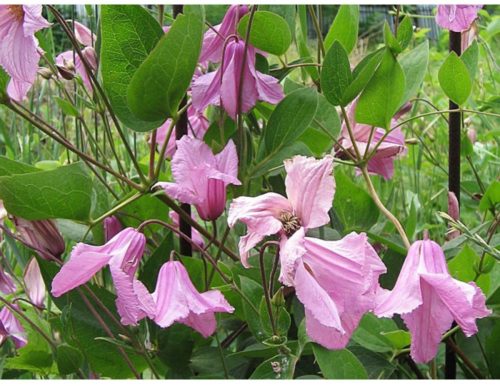
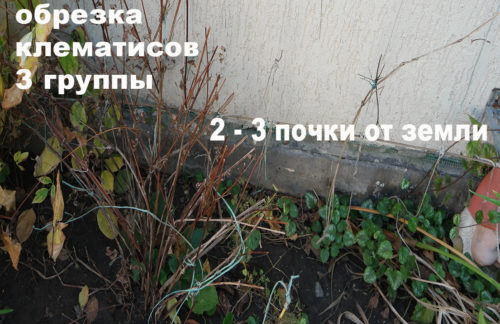
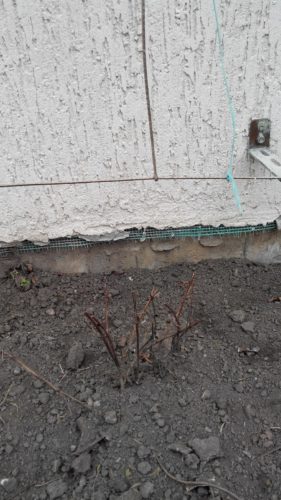
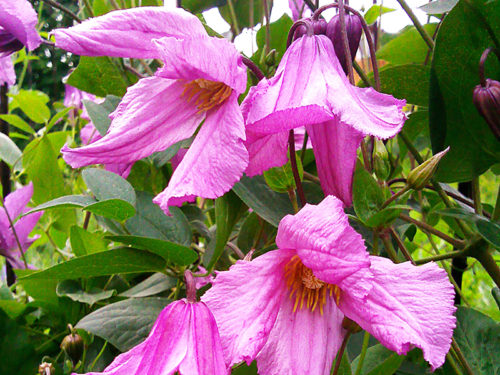













 Start a discussion ...
Start a discussion ...